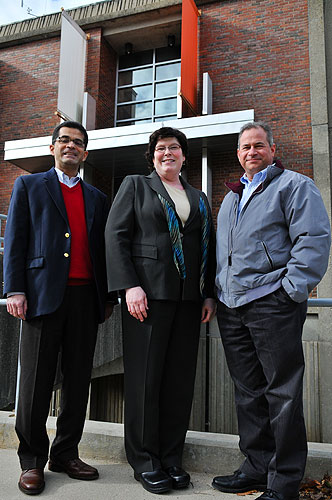The process of turning academic research into marketable technologies has just become easier for faculty on the Storrs campus.

In a move to expand its presence in the hub of one of UConn’s high-tech neighborhoods, the University’s Center for Science and Technology Commercialization (CSTC) – which helps researchers, faculty, and inventors protect their inventions and turn them into viable businesses – opened the doors to a new office last month, in Room 203 of the Arthur B. Bronwell Building.
Bronwell, located directly across from the Castleman Building and next to the United Technology Corp. Building, is part of a complex that includes most of the engineering school’s classrooms and labs. It is also near to the Gant Building, which houses physics, math, and science, and the Institute of Materials Science; the Pharmacy and Biology Building; the Torrey Life Sciences Building; and the Chemistry and Pathobiology buildings.
Announcing the CSTC’s new office via an e-mail message to the academic community, Suman Singha, UConn’s vice president for research, said its purpose is to better serve an area of the campus that has shown strong growth in technology-based research and economic development initiatives. Noting that intellectual property is a University priority, he added: “I hope that by having technology transfer resources close by we will increase the prospects for faculty conversations about issues that may provide a foundation for future opportunities.”
UConn’s push into “tech transfer,” barely 10 years old, appears to be working. In a letter to the University community last month, President Philip Austin noted that since the University entered this arena in 1999, “thus far the results have included 202 patents issued, 161 technology licenses and options, and 34 start-up companies. We can account for the creation of nearly 200 jobs in FY2010 through our commercialization programs.
“We are clearly in the foundation stages of an enterprise that may play a critical role in the coming years,” Austin added.
Rita Zangari, interim director of the Office of Technology Commercialization (OTC), which oversees the CSTC, notes that in general, “it is very difficult to transition research findings to a marketable product.” OTC’s approach, she adds, reflects the fact that universities are placing greater emphasis on commercializing their inventions, and licensing officials are taking steps to ensure that faculty members understand the process and have access to a range of services to support their interest in commercialization.
Under the 1980 Bayh-Dole Act, universities have the right to own and commercialize such inventions, Zangari explains. Most UConn professors recognize that an invention they develop based on research emanating from sponsored grants or with significant use of campus facilities belong to the University, and UConn shares any profits from those discoveries with the inventors and their departments.
“Many of our invention disclosures, patent filings, and business development projects come from faculty in the science, technology, and engineering areas,” Zangari adds, noting that while most faculty and graduate students in these fields may know about the ins and outs of commercializing university inventions, CSTC staff want to be close to the faculty and accessible should questions arise.
“We want to be closely involved and closely aligned with our inventors,” Zangari says. “These are the people we want to talk to. Hopefully closer proximity will give our licensing directors regular access to faculty in their labs, so when someone has an idea, they can easily find an opportunity to discuss it and learn about the potential service offerings.”
Donna Cyr, CSTC’s director of technology licensing in the physical sciences, says monitoring is part of the job. Licensing directors work as “harvesters” of new invention ideas by scouring university labs or by tracking UConn publications “for ideas that trigger a meeting with an investigator,” she says.
Mun Y. Choi, dean of the School of Engineering, says the opening of the CSTC Bronwell office is a good thing for both faculty researchers and the University.
“I think having a permanent presence here with high-level CSTC staff underscores the relevance with which the leading players in tech transfer view the Storrs campus and its research community,” Choi says. “It offers our inventors and scientists an unprecedented opportunity to see their ideas become realities faster than ever before.”
To contact CSTC licensing directors at Bronwell, please call 860-486-8330.


